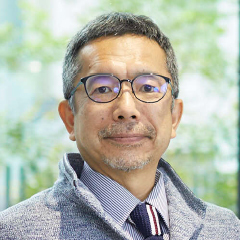The political philosophy of jinsei and bui in the Edo Period
Although the COVID-19 pandemic has been going on since 2020, Japan also suffered from a cholera pandemic in the last days of the Tokugawa Shogunate. How did Japanese people survive the pandemic in a situation where medicine was not as advanced as it is today?
Looking back on the Edo Period, we understand that society at the time was built under a firm political philosophy. This was jinsei and bui.
Bui is easy to understand. Before the Edo Period, a war-torn era, where various issues were resolved by military force, continued for 100 years. Many ordinary people were fed with this society. In 1615, Tokugawa Ieyasu ended the war-torn era by destroying Osaka Castle and ushered in a peaceful society represented by the term “gennaenbu,” which refers to arms being laid down. It was greatly welcomed by the general public.
After that, the Edo Shogunate maintained a peaceful society brought about by military force by frightening people with the authority of military power, not directly using military force and called bui.
On the other hand, farmers, who accounted for 90% of the population at that time, continued to pay a heavy annual land tax to their lord. Why did they pay the annual land tax?
The common people thought that their lord would help them whenever they were in trouble. They paid the annual land tax to their lord on the assumption that their lives and fortune were protected by their lord. This is jinsei.
Farmers were basically amenable to their lord and continued to pay the heavy annual land tax because a peaceful society was maintained through bui, and there was also jinsei, in which a ruler would help people when they were in trouble. People accepted the two political philosophies.
However, farmers rioted against their rulers when they had difficulty in paying the annual land tax, such as when a famine occurred owing to a natural disaster.
Actually, about 1,400 peasant revolts took place throughout the Edo Period. Basically, however, no riots occurred out of refusal to pay the annual land tax.
A peasant riot was when farmers asked their ruler for help because they were in poverty due to a poor rice harvest. They called the help osukui, and they rioted to get this help from their ruler.
Since society was built under jinsei, it was important for farmers to ask for help when they had difficulty. They did not need to use violence.
Therefore, a peasant riot at the time was different from that depicted in modern costume dramas, in which farmers flock to their rulers’ residence and resort to violence with a spade, a hoe, and a bamboo spear.
This social system based on the jinsei and the bui reached its peak of stability from 1688 to 1741. However, the social system began to destabilize from around 1829.
The orderly society became unstable owing to the collapse of jinsei and bui
There are several factors for the cause of the collapse of these systems, which were the political belief of the Edo Shogunate. The main reasons are that the bottom-up economy expanded and wealth began to be distributed unevenly. Although people conventionally restrained their desire under the influence of Confucianism, they began to lose their restraint since the rich became richer.
When the Tenpo famine occurred (1833-1839), the lords, rich merchants, and others thought of making profit from selling rice at a high price, and saving ordinary people was secondary. They began to destroy the state of jinsei and society sustained through mutual assistance because they were driven by greed.
This led to the loss of people’s sense of obligation to the Edo Shogunate, which was based on the jinsei.
Moreover, when Commodore Perry from the United States arrived at Uraga in 1853 and asked for the opening of the port, the Edo Shogunate took a weak-kneed response to the foreigners, who were despised as barbarians. This instantly destroyed the bui of the Edo Shogunate.
Traditional concepts of values and order began to collapse, since the philosophy supporting the Edo Shogunate collapsed.
For example, if a person was born in a farming village, it was common for the person to be a farmer in the social system at that time. Some young people who disliked the social system or did not have their own land because they were not an eldest son, ran away from the village and became a gambler, and some young people were loathed in their village.
For ordinally young people who did not have property or special abilities, resorting to violence was the only way to assert themselves. Some people, especially the young, asserted themselves without being bound by traditional order while they were depending on a village. Such people were called shitatakamono.
However, when jinsei and bui began to collapse, common people began to pay attention to the strong personality and the power of violence of the shitatakamono, and an atmosphere of relying on them was created.
In fact, some became leaders and carried out peasant revolts with violence. It can be said that this was a farmer’s action that had never existed in the traditional sense of value and order.
Moreover, a situation where the principle of reverence for the Emperor and the expulsion of foreigners gave a pretext to violence, was created. Although the loyal supporters of the Emperor became popular, many of them were lower-class samurai and young people from a farmer’s village who did not have dreams and possibilities in the traditional social system.
As a result, society in the last days of the Tokugawa Shogunate took on a chaotic situation because jinsei and bui, which were the foundation of the social system in the Edo Period, collapsed.
Young people who could only express themselves through violence were not the only ones who found their own place in society and came out ahead. Young people with originality and great ability were not going to easily waste their talents. Learning helped uncover their untapped talents.
From among them, those who saved society from the pandemic that struck Japan at the end of the Edo period appeared.
New power emerged in the pandemic
Pandemics caused by a plague or other reason have struck repeatedly around the world since the Age of Discovery. Japan had never experienced a pandemic because it adopted a policy of national isolation in the Edo Period.
However, in 1858, after the opening of the country, cholera spread from crew members of American ships docked at Nagasaki.
Vibrio cholera was undiscovered at that time, and there were no vaccines and no medicine. Japan suffered serious damage because it had only a limited knowledge of Western medicine.
In the previous year, however, Pompe van Meerdervoort, a surgeon from the Netherlands Navy, was sent to a medical school in Nagasaki. He predicted that a cholera epidemic would spread to Japan and took countermeasures against cholera soon after he arrived at his new place of work.
When the disease started to spread, Pompe, Ryojun Matsumoto, and other young apprentices in their 20s, who were earnestly learning Rangaku or Dutch studies, devoted themselves to treating patients at the cost of their own health.
Thanks to their efforts, Pompe and others were able to reduce the mortality of cholera patients to 36.4%. They say that this was a world-class achievement at a time when vibrio cholera was undiscovered and treatment was also not established.
Pompe wrote a summary of his cholera treatment experience in Nagasaki and immediately distributed it as a treatment guidebook all over the country. Koan Ogata received it in Osaka. He was not only a scholar of Dutch studies or Western learning and a doctor but also an educator at Tekijuku, a private school, which produced a large number of talented young people.
He was also working hard to take measures against cholera, which began to spread in Osaka. He thought that the guidebook Pompe compiled was not perfect for cholera treatment and issued Kororichijun, in which more detailed preventive measures and treatments were compiled.
However, when seeing Kororichijun, Ryojun was very angry that his master had been insulted and sent a protest letter to Koan.
After that, Ryojun curiously succeeded Koan and became the head of the School of Western Medical Science, but he was still a young man in his 20s and an apprentice of a foreign doctor at that time. On the other hand, Koan was in his 40s and a scholar achieving fame in Western learning.
Considering the social order in the Edo Period, it would impossible for Ryojun, who is younger than Koan, to protest against Koan, who is his senior. If he did, it was only natural that Koan pay no attention to his remarks, as a joke of a novice young man, and not take him seriously.
Koan rewrote Kororichijun and apologized to Pompe for his rudeness in the book’s preface.
For treatment, however, he did not rewrite the content that he believed to be correct. It seems that he had a strong belief and conscience as a scholar.
Young people, including Ryojun, strove at Nagasaki. Koan applied himself to new learning such as Western learning, and created a training ground called Tekijuku, taking advantage of his experience, and cultivated young human resources that included the likes of Yukichi Fukuzawa, and made efforts to improve the lives of people living in Osaka.
When looking at what they did, we understand that new strengths that were not produced in the traditional social systems, such as the movement to demonstrate one’s talents in society, arose at the end of the Edo period.
It shows that the thoughts of young people who did not have any way to express themselves except for violence expanded to other fields such as learning. However, the opportunities were limited.
Looking at the history of the last days of the Tokugawa period from perspectives like this, however lofty philosophy in society is, it encourages disparity and destroys its philosophy owing to people’s self-interests and egoism.
Precedent principles or “precedentism” (simply doing what is normally done) and conservatism alienate the dreams and possibilities of people living in society and create a rigid society without diversity.
We realize again that young people’s vitality, which may seem reckless, opens up a new era. However, it is not a spectacular one that is seen in dramas. Young people who chose violence through the Sonno Joi Movement (a movement revering the Emperor and eliminating foreigners) lost their lives owing to the violence.
We also realize that for those living in modern times, issues and events that happened in society 150 years ago are the same as those we are facing today.
* The information contained herein is current as of July 2022.
* The contents of articles on Meiji.net are based on the personal ideas and opinions of the author and do not indicate the official opinion of Meiji University.
* I work to achieve SDGs related to the educational and research themes that I am currently engaged in.
Information noted in the articles and videos, such as positions and affiliations, are current at the time of production.


